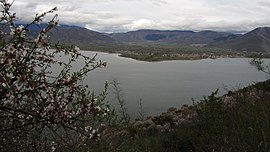Mavrochori
Mavrochori | |
|---|---|
Settlement | |
 Mavrochori (left), Polykarpi (right) | |
| Coordinates: 40°30′44″N 21°19′13″E / 40.51222°N 21.32028°E | |
| Country | Greece |
| Geographic region | Macedonia |
| Administrative region | Western Macedonia |
| Regional unit | Kastoria |
| Municipality | Kastoria |
| Municipal unit | Makednoi |
| Population (2011)[1] | |
| • Rural | 1,287 |
| Time zone | UTC+2 (EET) |
| • Summer (DST) | UTC+3 (EEST) |
Mavrochori (Template:Lang-el), meaning "black village"; before 1928: Μαύροβον - Mavrovon[2]) is a village on the shores of Lake Orestiada in Kastoria regional unit of Macedonia, Greece.[3]
Today Mavrochori is a tourist destination for a quiet vacation near the lake of Kastoria.[4] In addition to the trade fair, festive events take place on the 13th - 15th of August of the Assumption of Mary, where the Monastery of Panagia Mavriotissa celebrates (it was built by General George Palaiologos in commemoration of the victory against the Normans in 1083).[5] The Mavrochori Nautical Club also operates in the village.[6]
History
It was in existence at least from 1380[5] and is denoted, under the name Mavrobo, in the British Baldwin & Craddock Map of Greece which was published on 1 January 1830.[7] The name Mavros, together with the name Krepeni, is found in a title deed executed by Serbian nobleman Nikola Bagaš.[8]
In the end of the 18th century the patriarch of the Mavrovitis family moved his people from the nearby Krepeni village to Mavrovo in order to avoid a plague pandemic, and it is believed that people were frequently moving between Krepeni and Mavrovo.[5]
The Monastery of Panagia Mavriotissa, originally named Mesonisiotissa (meaning "in the middle of the island"), was built near the village.[5]
Mavrochori had a historical relationship with both the Mavriotissa monastery as well as with the nearby village of Krepeni.[5]
During Ottoman rule, Mavrovo was populated by Christians and Muslims, it had one Greek school and one Muslim school and five inns.[9]
The Greek census (1920) recorded 1062 people in the village and in 1923 there were 450 inhabitants (or 45 families) who were Muslim.[10] Following the Greek-Turkish population exchange, in 1926 within Mavrovo there were refugee families from Asia Minor (55), Pontus (19) and one other from an unidentified location.[10] The Greek census (1928) recorded 1065 village inhabitants.[10] There were 72 refugee families (320 people) in 1928.[10] There were two mosques and two Muslim cemeteries in the village, later all destroyed.[11]
Notable people
- Konstantinos Papastavrou, Greek chieftain of the Macedonian Struggle[12]
- Filippos Petsalnikos, Greek politician, served as Speaker of the Hellenic Parliament[13]
References
- ^ "Απογραφή Πληθυσμού - Κατοικιών 2011. ΜΟΝΙΜΟΣ Πληθυσμός" (in Greek). Hellenic Statistical Authority.
- ^ "Name Changes of Settlements in Greece: Mavrovon – Mavrochori". Pandektis. Retrieved 30 March 2022.
- ^ "Μαυροχώρι ΚΑΣΤΟΡΙΑΣ, Δήμος ΚΑΣΤΟΡΙΑΣ | buk.gr". buk.gr (in Greek). Retrieved 2022-01-28.
- ^ "ΜΑΥΡΟΧΩΡΙ ΚΑΣΤΟΡΙΑ, ταξίδι στο μύθο!". www.holiday.gr. Retrieved 2022-01-28.
- ^ a b c d e "Jason C. Mavrovitis, Out of the Balkans, Pt.1, Ch.2, p.29". www.pahh.com. Retrieved 2021-07-04.
- ^ "ΝΑΥΤΙΚΟΣ ΟΜΙΛΟΣ ΜΑΥΡΟΧΩΡΙΟΥ - ΟΙ ΑΡΓΟΝΑΥΤΕΣ". Nautical Club of Mavrochori (in Greek). Retrieved 2022-01-28.
- ^ "Map of the Balkan Peninsula". www.pahh.com. Retrieved 2022-01-28.
- ^ Nicholas K. Moutsopoulos, Kastoria, the Virgin of Mavriotissa (Athens: Friends of Byzantine and Ancient Monuments of Kastoria, 1967), 85. Cited in http://www.pahh.com/mavrovitis/ch2/chapter2b.html
- ^ Stavridopoulos 2015, p. 272.
- ^ a b c d Pelagidis, Efstathios (1992). Η αποκατάσταση των προσφύγων στη Δυτική Μακεδονία (1923-1930) [The rehabilitation of refugees in Western Macedonia: 1923–1930] (Ph.D.). Aristotle University of Thessaloniki. p. 76. Retrieved 30 March 2022.
- ^ Stavridopoulos, Ioannis (2015). Μνημεία του άλλου: η διαχείριση της οθωμανικής πολιτιστική κληρονομιάς της Μακεδονίας από το 1912 έως σήμερα [Monuments of the other: The management of the Ottoman cultural heritage of Macedonia from 1912 until present] (Ph.D.). University of Ioannina. pp. 272–273. Retrieved 28 March 2022.
- ^ Koliopoulos, Ioannis. "Αφανείς, γηγενείς Μακεδονομάχοι" (PDF). Society for Macedonian Studies (in Greek).
- ^ "Βιογραφικό - Φίλιππος Πετσάλνικος". petsalnikos.gr. 2011-11-11. Archived from the original on 2021-05-06.
{{cite web}}:|archive-date=/|archive-url=timestamp mismatch; 2011-11-12 suggested (help)

